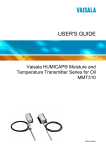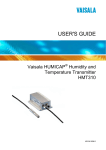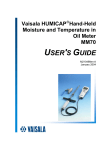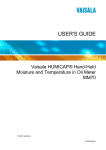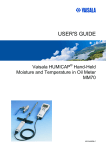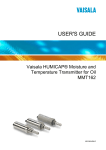Download Vaisala HUMICAP MMT310 User`s guide
Transcript
USER'S GUIDE ® Vaisala HUMICAP Moisture and Temperature Transmitter Series for Oil MMT310 M210474EN-B PUBLISHED BY Vaisala Oyj P.O. Box 26 FIN-00421 Helsinki Finland Phone (int.): +358 9 8949 1 Fax: +358 9 8949 2227 Visit our Internet pages at http://www.vaisala.com/ © Vaisala 2008 No part of this manual may be reproduced in any form or by any means, electronic or mechanical (including photocopying), nor may its contents be communicated to a third party without prior written permission of the copyright holder. The contents are subject to change without prior notice. Please observe that this manual does not create any legally binding obligations for Vaisala towards the customer or end user. All legally binding commitments and agreements are included exclusively in the applicable supply contract or Conditions of Sale. ________________________________________________________________________________ Table of Contents CHAPTER 1 GENERAL INFORMATION............................................................................ 3 About This Manual ................................................................... 3 Version Information ............................................................... 3 General Safety Considerations ............................................. 3 Feedback............................................................................... 4 Product Related Safety Precautions ...................................... 4 ESD Protection ......................................................................... 4 Recycling .................................................................................. 5 Regulatory Compliances ......................................................... 5 Trademarks ............................................................................... 5 License Agreement .................................................................. 5 Warranty.................................................................................... 7 CHAPTER 2 PRODUCT OVERVIEW.................................................................................. 9 Introduction to MMT318 and MMT317 .................................... 9 CHAPTER 3 MOUNTING .................................................................................................. 11 Selecting a place for the probe............................................. 11 Mounting the transmitter/Removing the transmitter unit .. 12 Mounting the MMT318............................................................ 13 Mounting for Pressurized Pipelines/Oils ............................. 13 Ball Valve Installation Kit for MMT318 ................................. 14 Tightening the Clasp Nut..................................................... 15 Mounting the MMT317 ........................................................ 17 MMT317 with Swagelok Connector for Tight-place Installations ......................................................................... 17 CHAPTER 4 WIRING......................................................................................................... 21 CHAPTER 5 OPERATION................................................................................................. 23 Power ON/OFF ........................................................................ 23 Giving the serial communication parameters ..................... 23 Measurement output .............................................................. 26 Output Formatting.................................................................. 29 VAISALA_____________________________________________________________________ 1 USER'S GUIDE____________________________________________________________________ Setting, scaling and testing the analog outputs .................32 Calibration and adjustment ...................................................34 Preparations before the calibration .....................................35 Relative humidity calibration and adjustment (in two points) ......................................................................35 Temperature calibration and adjustment (in one point).......38 Error states..............................................................................40 Other commands ....................................................................41 CHAPTER 6 MAINTENANCE............................................................................................45 Changing the filter and sensor..............................................45 Clean the sensor before storing the MMT318 and MMT317....................................................................................45 Factory calibration and repair service .................................45 Technical Support ..................................................................46 Return Instructions ................................................................46 Vaisala Service Centers .........................................................47 CHAPTER 7 TECHNICAL SPECIFICATIONS ..................................................................49 Accessories.............................................................................51 DIMENSIONS ...............................................................................................52 MMT317 with optional Swagelok Connector, Dimensions.54 APPENDIX 1 APPLICATIONS ...........................................................................................55 Transformer oils .....................................................................55 Ppm-calculation for transformer oils....................................56 Paper machine application ....................................................60 List of Tables Table 1 Manual Revisions .......................................................................3 2 ________________________________________________________________ M210474EN-B Chapter 1 ________________________________________________________ General Information CHAPTER 1 GENERAL INFORMATION This chapter provides general notes for the manual and the product. About This Manual This manual provides information for installing, operating, and maintaining MMT318 and MMT317. Version Information Table 1 Manual Code M21047EN-A M21047EN-B Manual Revisions Description MMT318 User's Guide MMT318 and MMT317 User's Guide. The manual has been updated with MMT317 installation instructions and MMT317 dimension figure. General Safety Considerations Throughout the manual, important safety considerations are highlighted as follows: WARNING Warning alerts you to a serious hazard. If you do not read and follow instructions very carefully at this point, there is a risk of injury or even death. VAISALA_____________________________________________________________________ 3 USER'S GUIDE____________________________________________________________________ CAUTION Caution warns you of a potential hazard. If you do not read and follow instructions carefully at this point, the product could be damaged or important data could be lost. NOTE Note highlights important information on using the product. Feedback Vaisala Customer Documentation Team welcomes your comments and suggestions on the quality and usefulness of this publication. If you find errors or have other suggestions for improvement, please indicate the chapter, section, and page number. You can send comments to us by e-mail: [email protected] Product Related Safety Precautions The MMT318 and MMT317 delivered to you has been tested for safety and approved as shipped from the factory. Note the following precautions: WARNING Ground the product, and verify outdoor installation grounding periodically to minimize shock hazard. CAUTION Do not modify the unit. Improper modification can damage the product or lead to malfunction. ESD Protection Electrostatic Discharge (ESD) can cause immediate or latent damage to electronic circuits. Vaisala products are adequately protected against ESD for their intended use. However, it is possible to damage the product by delivering electrostatic discharges when touching, removing, or inserting any objects inside the equipment housing. 4 ________________________________________________________________ M210474EN-B Chapter 1 ________________________________________________________ General Information To make sure you are not delivering high static voltages yourself: - Handle ESD sensitive components on a properly grounded and protected ESD workbench. When this is not possible, ground yourself to the equipment chassis before touching the boards. Ground yourself with a wrist strap and a resistive connection cord. When neither of the above is possible, touch a conductive part of the equipment chassis with your other hand before touching the boards. - Always hold the boards by the edges and avoid touching the component contacts. Recycling Recycle all applicable material. Dispose of batteries and the unit according to statutory regulations. Do not dispose of with regular household refuse. Regulatory Compliances The MMT318 and MMT317 comply with the following performance and environmental test standards: Trademarks Microsoft®, Windows®, Windows NT®, and Windows® 2000 are registered trademarks of Microsoft Corporation in the United States and/or other countries. License Agreement All rights to any software are held by Vaisala or third parties. The customer is allowed to use the software only to the extent that is VAISALA_____________________________________________________________________ 5 USER'S GUIDE____________________________________________________________________ provided by the applicable supply contract or Software License Agreement. 6 ________________________________________________________________ M210474EN-B Chapter 1 ________________________________________________________ General Information Warranty Vaisala hereby represents and warrants all Products manufactured by Vaisala and sold hereunder to be free from defects in workmanship or material during a period of twelve (12) months from the date of delivery save for products for which a special warranty is given. If any Product proves however to be defective in workmanship or material within the period herein provided Vaisala undertakes to the exclusion of any other remedy to repair or at its own option replace the defective Product or part thereof free of charge and otherwise on the same conditions as for the original Product or part without extension to original warranty time. Defective parts replaced in accordance with this clause shall be placed at the disposal of Vaisala. Vaisala also warrants the quality of all repair and service works performed by its employees to products sold by it. In case the repair or service works should appear inadequate or faulty and should this cause malfunction or nonfunction of the product to which the service was performed Vaisala shall at its free option either repair or have repaired or replace the product in question. The working hours used by employees of Vaisala for such repair or replacement shall be free of charge to the client. This service warranty shall be valid for a period of six (6) months from the date the service measures were completed. This warranty is however subject to following conditions: a) A substantiated written claim as to any alleged defects shall have been received by Vaisala within thirty (30) days after the defect or fault became known or occurred, and b) The allegedly defective Product or part shall, should Vaisala so require, be sent to the works of Vaisala or to such other place as Vaisala may indicate in writing, freight and insurance prepaid and properly packed and labelled, unless Vaisala agrees to inspect and repair the Product or replace it on site. This warranty does not however apply when the defect has been caused through a) normal wear and tear or accident; b) misuse or other unsuitable or unauthorized use of the Product or negligence or error in storing, maintaining or in handling the Product or any equipment thereof; c) wrong installation or assembly or failure to service the Product or otherwise follow Vaisala's service instructions including any repairs or installation or assembly or service made by unauthorized personnel not approved by Vaisala or replacements with parts not manufactured or supplied by Vaisala; d) modifications or changes of the Product as well as any adding to it without Vaisala's prior authorization; e) other factors depending on the Customer or a third party. Notwithstanding the aforesaid Vaisala's liability under this clause shall not apply to any defects arising out of materials, designs or instructions provided by the Customer. This warranty is expressly in lieu of and excludes all other conditions, warranties and liabilities, express or implied, whether under law, statute or otherwise, including without limitation any implied warranties of merchantability or fitness for a particular purpose and all other obligations and liabilities of Vaisala or its representatives with respect to any defect or deficiency applicable to or resulting directly or indirectly from the Products supplied hereunder, which obligations and liabilities are hereby expressly cancelled and waived. Vaisala's liability shall under no circumstances exceed the invoice price of any Product for which a warranty claim is made, nor shall Vaisala in any circumstances be liable for lost profits or other consequential loss whether direct or indirect or for special damages. VAISALA_____________________________________________________________________ 7 USER'S GUIDE____________________________________________________________________ 8 ___________________________________________________________________ M210474EN-B Chapter 2 __________________________________________________________ Product Overview CHAPTER 2 PRODUCT OVERVIEW This chapter introduces the features, advantages, and the product nomenclature. Introduction to MMT318 and MMT317 Vaisala HUMICAP® moisture in oil transmitter MMT318 and MMT317 are designed for industrial applications. The MMT318 and MMT317 transmitter measure water in oil in terms of water activity (aw) which can be determined as follows: water activity indicates the amount of oil in the scale of 0 - 1 aw. In this scale, 0 aw is an indication of completely water free oil and 1 aw an indication of oil fully saturated with water. Water is present in free form. The water activity is used for alarming at the point of > 0.9 aw where the risk for free water is obvious. The most advanced feature which distinguishes the measurement of water activity (aw) from the traditional measurement of absolute water content (in ppm) is that the in the water activity measurement saturation point remains stable regardless of the oil type, aging of oil or additives used. As water activity of the oil exceeds 0.9 aw, there is a risk for segregation (especially if the temperature decreases). The MMT318 and MMT317 transmitters can be used for continuous on-line measurements and it can be calibrated against salt solutions, no reference oils are needed. Appendix presents application information when using the MMT318 and MMT317 with transformer oil (output unit= ppm). General information on paper machine use is also included in the Appendix. VAISALA ________________________________________________________________________ 9 USER'S GUIDE____________________________________________________________________ The MMT318 and MMT317 powers up with 24 VDC. Output alternatives are analog outputs 0/4... 20mA and RS232C serial line. The transmitter measures and calculates the following quantities: Quantity aw water activity T Temperature ppm (for transformer oil only) Metric Unit aw °C ppm Non Metric Unit aw °F ppm Removable transmitter unit Mounting plate (two alternative sizes) Connector for signal output and power supply Probe 10 __________________________________________________________________ M210474EN-B Chapter 3 _________________________________________________________________Mounting CHAPTER 3 MOUNTING Selecting a place for the probe Select a place which gives a true picture of the process. Oil should circulate freely around the sensor; clear oil flow is recommended. Install the probe directly into the circulation system and not into the oil reservoir because of deposition. It is recommended that the sensor head is installed directly in the process through the ball valve assembly. When the ball valve assembly is used, the pipe does not have to be emptied or shut down for installation or removal of the probe. Install the sensor head transversely against the direction of the process flow. NOTE NOTE Avoid mounting the transmitter housing close to steam sources or directly exposed to rain. To ensure an IP 65 class protection. Always mount the transmitter housing with the cable bushings pointing downwards. Take care not to damage the pipe of the probe. If the pipe is damaged, the probe head is less tight and will not go through the clasp nut. Make sure that the filter is tightly fastened to protect the sensors. VAISALA _______________________________________________________________________ 11 USER'S GUIDE____________________________________________________________________ Mounting the transmitter/Removing the transmitter unit 1. Mount the plate onto the wall by using four/two screws (∅4.5 mm/6.0 mm). 2. Place the transmitter onto the mounting plate and fasten it by using two allen screws. The transmitter module can be unfastened for calibration by releasing two allen screws on the left side. Two screw holes (∅ 6.0 mm) on the base of the plate for wall mounting (screws not provided) Four screw holes (∅ 4.5 mm) for wall mounting (screws not provided) Two allen screws for fastening/removing the transmitter module (allen key provided) Mounting with bigger mounting plate NOTE Mounting with smaller mounting plate It is recommended that the supply is switched off, before connecting the cable plug to transmitter during installation or service/calibration. 12 __________________________________________________________________ M210474EN-B Chapter 3 _________________________________________________________________Mounting Mounting the MMT318 NOTE Do not unsolder and then again resolder the sensor head cable from and to the printed board during installation; this procedure may alter the humidity calibration of the transmitter. Mounting for Pressurized Pipelines/Oils Due to the sliding fit, the MMT318 is easy to install into and remove from the pressurized process. The probe is especially suitable for the measurements in pipelines. 1 2 1. clasp nut, 24 mm hex nut 2. fitting body, 27 mm hex head MMT318 pipe dimensions (in mm); standard 178 (adjustment range 120 mm) and optional 400 mm (adjustment range 340 mm). Adjust the probe to a suitable depth according to the type of installation and tighten the clasp nut first manually. Mark the fitting body and the clasp nut. Tighten the nut a further 50 - 60° (ca.1/6" turn) with a fork spanner. If you have a suitable torque spanner, tighten the nut to 45±5 Nm (33±4 ft-lbs). Be careful not to over tighten' the nut. When the probe is used in a pressurized processes the sensor head should preferebly be installed through a ball valve assembly. VAISALA _______________________________________________________________________ 13 USER'S GUIDE____________________________________________________________________ CAUTION Take care not to damage the probe body. A damaged body makes the probe head less tight and may prevent it from going through the clasp nut. Use teflon tape or thread sealant to seal the connection between the fitting body and the process/ ball valve, see Figure below. Ball Valve Installation Kit for MMT318 The ball valve installation kit (Vaisala order code: BALLVALVE-1) is preferred when connecting the probe to a pressurized process or pipeline. Use the ball valve set or a 1/2" ball valve assembly with a ball hole of Ø14 mm or more. If you install the sensor head (Ø 12 mm) in a process pipe, please note that the nominal size of the pipe must be at least 1 inch (2.54 cm). Use the manual press handle to press the sensor head into the pressurized (< 10 bar) process or pipeline. 1. Shut down the process if the process pressure is more than 10 bars. If the pressure is lower there is no need to shut down the process. 2. Make the installation according to the figure below. Install the sensor head transversely against the direction of the process flow. 14 __________________________________________________________________ M210474EN-B Chapter 3 _________________________________________________________________Mounting You can not close the valve if the groove (7) is not in sight. When installing the sensor head through the Ball Valve Assembly it is not necessary to empty or shut down the process for installing or removing the sensor head. 1. Mount the probe with the ball valve assembly closed; tighten the clasp nut manually. Add tape or other sealing according to instructions, see figure on page 14. 2. Open the ball valve assembly. 3. Push the probe head through the ball valve assembly into the process. If the pressure is high, use a manual press handle. Note that the sensor head must be pushed so deep that the filter is completely inside the process flow. 4. Tighten the clasp nut a further 50-60º. Tightening the Clasp Nut 1. Adjust the probe to a suitable depth according to the type of installation. 2. Tighten the clasp nut first manually. 3. Mark the fitting body and the clasp nut. 4. Tighten the nut a further 50 -60º (ca. 1/6 turn) with a wrench. If you have suitable torque spanner, tighten the nut to max 45 ± 5 Nm (33 ± 4 ft-lbs). 1 2 3 max . 60° 4 0511-109 Tightening the Clasp Nut The following numbers refer to above: 1 2 3 = = = Probe Clasp nut Pen VAISALA _______________________________________________________________________ 15 USER'S GUIDE____________________________________________________________________ The following numbers refer to above: 4 = Fitting body NOTE Take care not to over tighten the clasp nut to avoid difficulties when opening it. CAUTION Take care not to damage the probe body. A damaged body makes the probe head less tight and may prevent it from going through the clasp nut. CAUTION In pressurized processes it is essential to tighten the supporting nuts and screws very carefully to prevent loosening of the probe by the action of pressure. Stage 1 Stage 2 6 1. probe 1 2. Tighten first manually; probe is then sliding easily. Finally tighten with a spanner about 60° more, to have a stable installation, Note: do not overtighten this screw!. 7 2 3 3. handle of the ball valve 4. ball of the ball valve 3 Valve closed 4 5. process chamber / pipeline 6. manual press tool 5 7. the groove on the probe indicates the upper adjustment limit 16 __________________________________________________________________ M210474EN-B Chapter 3 _________________________________________________________________Mounting NOTE It is recommended that the supply is switched off, before connecting the cable plug to the transmitter during installation or service/calibration. Mounting the MMT317 The MMT317 has a small pressure-tight probe and it is ideal for tight spaces with threaded connection. The small probe is installed using the threaded fitting bodies, see below. NOTE Do not unsolder and then again resolder the sensor head cable from and to the printed board during installation; this procedure may alter the humidity calibration of the transmitter. MMT317 with Swagelok Connector for Tight-place Installations Swagelok installation kit for the MMT317 includes Swagelok connector with ISO3/8" thread ( Vaisala order code: SWG12ISO38) or NPT1/2" thread (Vaisala order code: SWG12NPT12). See figure below for MMT317 with Swagelok Installation Kit. VAISALA _______________________________________________________________________ 17 USER'S GUIDE____________________________________________________________________ The following numbers refer to figure MMT317 Probe Installation to Pipeline with Swagelok Installation Kit above: 1 2 3 4 5 6 7 1. = = = = = = = Probe Duct connector ISO3/8" or NPT1/2" thread Swagelok connector Ferrules Upper edge of the connector nut Upper edge of the probe Preparing Installation. The connector options are the following: a. R3/8" ISO (Swagelok code SS-12M0-1-6RTBT) b. 1/2" NPT (Swagelok code SS-12M0-1-8BT) Note that the connector inner diameters extend for Ø12 mm probe. 2. Probe position. Before the final tightening check that the upper edge of the connector nut is in line with the upper edge of the probe. Otherwise the sealing may not be gas tight. 3. Gas tight sealing a. Turn the connector nut finger tight and draw a vertical mark on the nut and the fitting body. b. Be sure that the probe position follows step 2. c. Tighten the connector nut with a wrench 1 and 1/4 turns (360º +90º) with the help of marks you drew. The connector has now a gas tight connection to the probe. Excess tightening can damage the probe. 18 __________________________________________________________________ M210474EN-B Chapter 3 _________________________________________________________________Mounting d. Connector can be disconnected and re-installed. In reinstallation first turn the connector nut finger tight and then with wrench 1/4 turn (90º). Use teflon tape or thread sealant to seal the connection between the Swagelok connector and the process, see figure below. VAISALA _______________________________________________________________________ 19 USER'S GUIDE____________________________________________________________________ This page intentionally left blank. 20 __________________________________________________________________ M210474EN-B Chapter 4 ___________________________________________________________________ Wiring CHAPTER 4 WIRING When the MMT318 and MMT317 leave the factory, their measurement ranges, output scaling and quantities have already been set according to order completed by a customer. The unit is calibrated at the factory and the device is ready for use. Transmitter is delivered with screw terminal connector or with detachable 5m cable with eight wires for serial port, analog outputs and 24VDC power supply. See the wiring instructions below. Cable wiring 5 GREY (GND) Cable color codes and functions: 1 White RS232C TX 2 Brown RS232GND 6 PINK (+24VDC) 3 Green CH2+. 4 Yellow CH1+. 5 Grey Supply-/CH1-/CH2 7 BLU (RX) 6 Pink Supply +24VDC 7 Blue RS232C RX 1 WHT (TX) 8 Red Not connected 4 YEL (CH1+) 3 GRN (CH2 +) 2 BRN (RS232GND) 8 RED (NOT CONNECTED) Screw terminal connector Cable codes and functions: 1 RS232C TX 2 RS232GND 3 CH2+. 4 CH1+. 5 Supply- /CH1-/CH2 6 Supply +24VDC 7 RS232C RX 8 Not connected 5 6 4 7 3 1 2 8 VAISALA _______________________________________________________________________ 21 USER'S GUIDE____________________________________________________________________ 22 __________________________________________________________________ M210474EN-B Chapter 5 ________________________________________________________________ Operation CHAPTER 5 OPERATION Power ON/OFF Switch ON the power supply 24VDC and the transmitter turns on. Giving the serial communication parameters The transmitter communicates via an RS232C serial interface. The transmitter can be polled or set on run mode with specific commands. The data format will be (factory settings): - 1 Start Bit - 7 Data Bits - 1 Stop Bit - Even Parity - 4800 bits per second, programmable to 19200 - Full Duplex - Serial Asynchronous - Configured as Data Terminal Equipment (DTE) Give the communication parameters when using this terminal session for the first time; save them for future use. See instructions in the following tables. VAISALA _______________________________________________________________________ 23 USER'S GUIDE____________________________________________________________________ Giving parameters in Windows 95 and Windows NT WINDOWS 95 MENU Start Ø Programs Ø Accessories Ø HyperTerminal Ø Hypertrm WHAT TO DO move the cursor to: move the cursor to: move the cursor to: click move the cursor to: double click Ø Connection Description WINDOWS NT MENU Start Ø Programs Ø Accessories Ø WHAT TO DO move the cursor to: move the cursor to: move the cursor to: HyperTerminal Ø Hyperterminal move the cursor to: click Ø type the name of the connection in the appropriate field and select an icon if available; click OK. Connection Description type the name of the connection in the appropriate field and select an icon if available; click OK. Ø Phone Number move the cursor to the field CONNECT USING and select 'direct to COM x' (x = serial port available); click OK Ø COM x properties Connect to move the cursor to the field CONNECT USING and select 'COM x' (x = serial port available); click OK Ø select parameters according to the previous figure; click OK COM x properties select parameters according to the previous figure, click OK Selecting the parameters in Windows 95 and NT. 24 __________________________________________________________________ M210474EN-B Chapter 5 ________________________________________________________________ Operation Commands The bold text in the brackets is a default setting. Give commands by typing them on your computer. ↵ stands for pressing ENTER. This page presents the command list, the commands are described in details later in this chapter. Measurement output R S INTV [0…255 S/MIN/H] SEND [0…99] SMODE [STOP/RUN/POLL] SERI [baud p d s] ADDR [0…99] CLOSE OPEN [0…99] Starting the continuous outputting Stopping the continuous outputting Setting the continuous output interval Outputting the reading once Setting the serial interface Serial line settings (default: 4800 E 7 1) baud: 300…19200 Setting the address Closing the line to POLL mode Opening temporarily connection to the POLL-mode device Output formatting FORM DATE TIME FDATE [ON/OFF] FTIME [ON/OFF] UNIT Setting the output format of SEND and R commands Entering the date Setting the time Adding date to R and SEND outputs Adding time to output to SEND and R outputs Selecting the metric or non-metric output units Calibration and adjustment CDATE CRH CT CTEXT FCRH LI Setting the calibration date Relative humidity calibration Temperature calibration Giving the text to calibration information field Relative humidity calibration after sensor change Reverting the factory calibration Setting and testing the analog outputs AMODE ASEL ASCL ITEST Setting the analog outputs Selecting the parameter for the analog outputs Scaling the analog outputs Testing the analog outputs Error states ERRS AERR Listing the error messages Changing the analog error output value Other commands ? ?? ECHO [ON/OFF] FIND FILT RESET Outputting the information about the device Outputting the information about the device in POLL-state Turning the serial interface echo ON/OFF All devices in POLL mode send their addresses Setting the result filtering Resets the transmitter VAISALA _______________________________________________________________________ 25 USER'S GUIDE____________________________________________________________________ Measurement output R Starting the continuous outputting R↵ Starts output of measurements to the peripheral devices (RUN mode); the only command that can be used is S (stop). The output mode can be changed with command FORM. Example: >r aw= aw= S 0.2000 aw T= 0.2000 aw T= 25.09 'C … 25.20 'C … Stopping the continuous outputting S↵ Stops the continuous output. Also <ESC> can be used to stop outputting. INTV Setting the continuous outputting interval for the RUN mode INTV xxx yyy ↵ xxx= yyy= output interval (0...255) unit (s, min or h) Example: >intv 1 Output interval: 1 S >intv 1 min Output interval: 1 MIN >intv 1 h Output interval: 1 H 26 __________________________________________________________________ M210474EN-B Chapter 5 ________________________________________________________________ Operation SEND Outputting the reading once In STOP mode: SEND ↵ In POLL mode: SEND aa ↵ aa = address of the transmitter when more than one transmitter is connected to a serial bus (0...99) Example. >send aw= 0.2 aw T= -47.37 'C … If value is too long to fit to the allocated space or if there is an error in outputting, value is displayed with stars ‘*’. For example, aw=*.* aw T= 31.0 'C The output mode can be changed with command FORM. SMODE Setting the serial interface mode SMODE x↵ X= STOP/RUN/POLL STOP MODE: Transmitter in standby for serial commands. RUN MODE: Transmitter outputs data continuosusly. POLL MODE: Transmitter only responds to addressed commands >smode run Output mode : RUN >r 02:08:01.03 aw= 02:08:04.21 aw= <ESC> >smode stop Output mode 0.2 aw T= 0.2 aw T= -47.13 'C … -47.16 'C … : STOP VAISALA _______________________________________________________________________ 27 USER'S GUIDE____________________________________________________________________ SERI Serial line settings SERI b p d s ↵ b = bauds (300, 600, 1200, 2400, 4800, 9600,19200) p = parity (n = none, e = even, o = odd) d = data bits (7 or 8) s = stop bits (1 or 2) The settings can be changed one parameter at a time or all parameters at once: >SERI O ↵ 4800 O 7 1 >SERI 600 N 8 1 ↵ 600 N 8 1 ADDR changing parity only changing all parameters Setting the transmitter address for use in POLL-mode. ADDR aa ↵ aa = address (0...99) Example: >addr Address >addr 1 Address OPEN : 0 : 1 Temporarily opens transmitter from POLL-mode to receive serial commands OPEN nn ↵ nn = address of the transmitter (0...99) The OPEN command sets the bus temporarily in STOP mode so that the SMODE command can be given. Example: open 4 Device: > 4 line opened for operator commands 28 __________________________________________________________________ M210474EN-B Chapter 5 ________________________________________________________________ Operation CLOSE Set transmitter in poll-mode CLOSE ↵ In STOP mode: command OPEN has no effect, CLOSE sets the transmitter temporarily in POLL mode In POLL mode: command OPEN sets the transmitter temporarily in STOP mode, command CLOSE returns the instrument to POLL mode Example: relative humidity calibration is performed at transmitter 2 which is in POLL mode >OPEN 2 ↵ >CRH ↵ ... >CLOSE ↵ opens the line to transmitter 2 calibration started line closed Output Formatting FORM Serial output format FORM x ↵ x = formatter string Command format can be used to change the format of the output commands ‘SEND’ and ‘R’. Modifiers: x.y #t #r #n “” U5 length modifier (whole numbers and decimal places) tabulator carridge-return line feed string constant unit field and lenght >form "aw="1.2 aw #r#n aw=0.79 VAISALA _______________________________________________________________________ 29 USER'S GUIDE____________________________________________________________________ >form "aw="1.2 aw U3 #t "ppm="3.1 ppm " " U5 #t "T="3.1 T U3 #r#n aw=0.78 ppm= 53.4 ppm T= 27.3'C > >send 2000-01-01 20:56:27 N 53.2 ppm T= 27.2'C > TIME, DATE 0 aw=0.78 ppm= Setting time and date TIME ↵ DATE ↵ Sets the time and date to the transmitter. TIME↵ Current time is 04:12:39 Enter new time (hh:mm:ss) ? 12:24:00↵ >DATE↵ Current date is 2000-01-01 Enter new date (yyyy-mm-dd) ? 2001-12-11↵ > NOTE Time and date are cleared to 2000-01-01 00:00:00 at reset. NOTE Only about 1% accuracy is obtained with the software clock. 30 __________________________________________________________________ M210474EN-B Chapter 5 ________________________________________________________________ Operation FTIME, FDATE Adding time and date to R and SEND outputs FTIME x ↵ FDATE x ↵ x = ON or OFF Command will enable/disable output of time and date to the serial line. >send aw= 0.2 aw T= 31.0 'C >ftime on Form. time : ON >send 03:47:59 aw= 0.2 aw T= 31.0 'C >fdate on Form. date : ON >send 2000-01-01 03:48:03 aw= 0.2 aw T= 31.0 'C > UNIT Selecting metric or non-metric output units UNIT x ↵ x = M or N M = metric units N = non-metric units * Quantity aw T ppm* Metric Unit °C ppm Non Metric Unit °F ppm for transformer oil only VAISALA _______________________________________________________________________ 31 USER'S GUIDE____________________________________________________________________ Setting, scaling and testing the analog outputs You can select for the two outputs - current range (0...20 mA/4...20 mA) and output parameter (aw/ ppm*/ T). and scale the two outputs according to your needs. * AMODE for transformer oil only Setting the analog outputs (0...20 mA/4...20 mA) AMODE ch1 ch2 ↵ where ch1 and ch2: I0 = 0...20 mA I1 = 4... 20 mA >amode i1 i1↵ Ch1 output mode: 4...20mA Ch2 output mode: 4...20mA > If the output includes a reminder 'remember to set jumpers', please ignore the reminder. ASEL Selecting the parameter for the analog outputs ASEL xxx yyy ↵ where: xxx = quantity of channel 1 and yyy = quantity of channel 2. Use abbreviations shown in the table below. Quantity aw water activity T Temperature ppm (for transformer oil only) abbreviation aw T ppm Examples: >asel aw t Ch1 aw lo : 0.00 ? 32 __________________________________________________________________ M210474EN-B Chapter 5 ________________________________________________________________ Operation Ch1 aw hi Ch2 T lo Ch2 T hi >asel t ppm Ch1 T lo Ch1 T hi Ch2 ppm lo Ch2 ppm hi > * ASCL : : : : : : : 1.00 -40.00 'C 60.00 'C -40.00 60.00 0.00 5000.00 'C 'C ppm ppm ? ? ? ? ? ? ? ppm calculation only for transformer oils Scaling the analog outputs ASCL ↵ Example: >ascl Ch1 T Ch1 T Ch2 ppm Ch2 ppm >ascl Ch1 T Ch1 T Ch2 ppm Ch2 ppm * ITEST lo hi lo hi : : : : -40.00 60.00 0.00 5000.00 'C 'C ppm ppm ? ? ? ? lo hi lo hi : : : : -20.00 40.00 0.00 3000.00 'C 'C ppm ppm ? ? ? ? -20 40 0 3000 ppm calculation only for transformer oils Testing the analog outputs The operation of the analog outputs are tested by forcing the outputs to given values. The values in the analog outputs can then be measured with a current/voltage meter. ITEST aa.aaa bb.bbb ↵ where: aa.aaa = current value to be set for channel 1 bb.bbb = current value to be set for channel 2 mA VAISALA _______________________________________________________________________ 33 USER'S GUIDE____________________________________________________________________ For example: >ITEST 8 12 ↵ 8.000mA 3F8 12.000mA > 70O The set values remain valid until you give the command ITEST without readings or RESET the transmitter. AQTEST Testing the analog outputs for desired readings Use command ‘AQTEST’ to test current values of desired aw or T readings. Current output is forced to correspond the chosen values. AQTEST x yyy.yyy ↵ where: x = aw / T / ppm yyy.yyy = value For example: >AQTEST aw 0.5↵ CH1 aw : 0.5000 aw CH2 T : 22.3 'C > 10.000mA 7.568mA The set values remain valid until you give the command AQTEST without a value or RESET the transmitter. Calibration and adjustment The MMT318 and MMT317 are calibrated as shipped from the factory. Typical calibration interval is one year. Depending on the application it may be good to make the first calibration check earlier. Calibration of the MMT318 and MMT317 can be carried out by the user according to the instructions given in this chapter. The device can also be sent to Vaisala for calibration. See Vaisala Service Centers' contact information on page 47. 34 __________________________________________________________________ M210474EN-B Chapter 5 ________________________________________________________________ Operation Relative humidity calibration must be done always after sensor change. Preparations before the calibration Before the calibration the used sensor should be cleaned with instrument air to blow out existing oil or gently first flush with heptane (C7H14 16) and dry with instrument air to decrease response time. The claning shall be done as the dirty sensor can contamine the salt bath and change the reference condition. NOTE It is important to clean the sensor before calibration as the dirty sensor can contamine the salt bath and change the reference condition. Relative humidity calibration and adjustment (in two points) Relative humidity calibration and adjustment of the MMT318 and MMT317 is done by using two reference humidities, difference between the two humidity references must be at least 50% RH. An easy calibration can be done by using Vaisala Humidity Calibrator HMK15. If using HMK15 calibrator, please use the adapter fitting (13.5 mm) with the MMT318 and MMT317 probe. Before calibrations the MMT318 and MMT317 must be set to adjustment mode by pressing once the adjustment button, see picture. VAISALA _______________________________________________________________________ 35 USER'S GUIDE____________________________________________________________________ Adjustment button Low end adjustement 1. Remove the transmitter unit from the mounting plate (see page 12), and press the adjustment button once, see picture. 2. Remove the filter from the probe and insert the probe head into a measurement hole of the dry end reference chamber (e.g. LiCl: 11 % RH in the humidity calibrator HMK15, please use the adapter fitting (13.5 mm)). 3. Wait at least 30 minutes for the sensor to stabilize. 4. Give command CRH and press ENTER. CRH ↵ Type C and press ENTER a few times to check if the reading is stabilized. 5. When the reading is stabilized, give the reference humidity after the question mark and press ENTER. >crh RH : 11.25 Ref1 ? c RH : 11.25 Ref1 ? c RH : 11.25 Ref1 ? c RH : 11.24 Ref1 ? c RH : 11.24 Ref1 ? 11.3 Press any key when ready ... Now the device is waiting for the high end reference. 36 __________________________________________________________________ M210474EN-B Chapter 5 ________________________________________________________________ Operation High end adjustement 6. After having made the low end adjustment, insert the probe head into a measurement hole of the high end reference chamber (e.g. NaCl: 75 % RH chamber in the humidity calibrator HMK15, please use the adapter fitting (13.5 mm)). Please, note that the difference between the two humidity references must be at least 50% RH. 7. Let the probe stabilize at least 30 minutes. You can follow the stabilization by pressing any key, typing C and pressing ENTER. 8. When stabilized, type the high end reference value after a question mark and press ENTER. >crh RH : 11.25 Ref1 ? c RH : 11.24 Ref1 ? c RH : 11.24 Ref1 ? 11.3 Press any key when ready ... RH RH RH RH OK > OK : : : : 75.45 75.57 75.55 75.59 Ref2 Ref2 Ref2 Ref2 ? ? ? ? c c c 75.5 indicates that the calibration has succeeded 9. Take the probe out of the reference conditions and replace the filter. Take care to tighten the filter properly, recommended force 130 Ncm. 10. If needed, give the calibration information (date and text) to the transmitter's memory, see the serial commands on page 29. 11. Reset the transmitter by giving a command RESET. Transmitter returns to normal mode. VAISALA _______________________________________________________________________ 37 USER'S GUIDE____________________________________________________________________ Temperature calibration and adjustment (in one point) 1. Remove the transmitter unit from the mounting plate (see page 12) and press the adjustment button, see page 26 . 2. Remove the probe filter and insert the probe head into the reference temperature. 3. Let the sensor stabilize. 4. Type command CT and press ENTER. CT ↵ 5. 6. Type C and press ENTER a few times to check if the reading is stabilized. When the reading is stabilized, give the reference temperature after the question mark and press ENTER three times. >ct > OK T : 16.06 Ref1 ? c T : 16.06 Ref1 ? c T : 16.06 Ref1 ? c T : 16.06 Ref1 ? c T : 16.06 Ref1 ? c T : 16.06 Ref1 ? 16.0 Press any key when ready ... T : 16.06 Ref2 ? OK indicates that the calibration has succeeded 7. Take the probe out of the reference conditions and replace the filter. Take care to tighten the filter properly, recommended force 130 Ncm. 8. If needed, give the calibration information (date and text) to the transmitter's memory, see the serial commands on page 29. 9. Reset the transmitter by giving a command RESET. Transmitter returns to normal mode. 38 __________________________________________________________________ M210474EN-B Chapter 5 ________________________________________________________________ Operation LI Reverting the factory calibration 1. Remove the transmitter unit from the mounting plate (see page 12) and press the adjustment button, see page 26. 2. Type command LI and give value 0 for an offset value and value 1 for a gain value. LI ↵ >li RH offset RH gain T offset T gain > : : : : -0.6000000 1.00000000 0.00000000 0.40000000 ? ? ? ? 0 1 0 1 3. Reset the transmitter by giving a command RESET. Transmitter returns to normal mode FCRH Relative humidity calibration after sensor change FCRH ↵ The transmitter asks and measures relative humidity and calculates the calibration coefficients. This 2-point adjustment should be performed after a sensor change. Follow the more detailed calibration instructions on page 35, but instead of giving CRH command, use FRCH command. >FCRH ↵ RH : 1.82 1. ref ? 0 ↵ Press any key when ready... ↵ RH : 74.22 2. ref ? 75 ↵ OK > The OK indicates that the calibration has succeeded. CTEXT Giving text to calibration information field CTEXT ↵ VAISALA _______________________________________________________________________ 39 USER'S GUIDE____________________________________________________________________ Set calibration info text. CTEXT↵ Cal. info > CDATE : Vaisala/HEL ? HMK15↵ Giving date to calibration information field CDATE yyyy mm dd↵ Set calibration date. CDATE 2001 12 11 Calibration : 2001-12-11 > Error states ERRS Displaying the error messages ERRS ↵ Display transmitter error messages. If there are no errors present, a PASS is returned. Example 1: >ERRS PASS > Example 2: >ERRS FAIL Error: Temperature measurement malfunction Error: Humidity sensor open circuit > 40 __________________________________________________________________ M210474EN-B Chapter 5 ________________________________________________________________ Operation In case of constant error, please contact Vaisala Service Centers, see page 47. AERR Setting the error outputs Factory default state for analog outputs during error condition is 0 mA. Please be careful when selecting the new error value, the error state of the transmitter should not cause problems in process monitoring. AERR ↵ Example: >aerr Ch1 error out Ch2 error out > : 0.000mA ? : 0.000mA ? NOTE Error output value must be within a valid range for output type. NOTE The error output value is shown only when there are minor electrical faults such as a humidity sensor open circuit. When there is a severe device malfunction, like analog output electronics failure or microprocessor ROM/RAM failure, the error output value is not necessarily shown. Other commands ? Checking transmitter settings Use command ‘?’ to check the current transmitter configuration. Command ‘??’ is similar, but can also be used if the transmitter is in POLL state. ?↵ ?? ↵ VAISALA _______________________________________________________________________ 41 USER'S GUIDE____________________________________________________________________ Example (factory default settings): >? HMT310 / 1.03 PRB serial nr : V1234567 Calibration : 2003-03-25 Cal. info : NU/HMK15 Output units : metric Pressure : 1013.25 hPa RS232 settings Address : 2 Output interval: 1 MIN Baud P D S : 4800 E 7 1 Serial mode : STOP Analog outputs Ch1 output mode: 0 ...20mA Ch2 output mode: 4 ...20mA Ch1 error out : 0.000mA Ch2 error out : 0.000mA Ch1 T lo : -40.00 'C Ch1 T hi : 60.00 'C Ch2 ppm lo : 0.00 ppm Ch2 ppm hi : 5000.00 ppm > ECHO Serial bus echo ECHO x ↵ x = ON or OFF (default=ON) Use commands to enable/disable echo of characters received over the serial line. FIND All devices in POLL mode are sending their addresses. FIND ↵ HELP Listing the commands. HELP ↵ 42 __________________________________________________________________ M210474EN-B Chapter 5 ________________________________________________________________ Operation FILT Setting the result filtering Configure type of filtering that will be used for all outputs. FILT xx↵ where: xx = OFF, ON or EXT OFF = No filtering (default) ON = Short filter of about 15 s (results the average value of the last 15 s measurement data). EXT = Extended filter of about 1min (results the average value of the last 1 min measurement data). RESET Resets the transmitter RESET ↵ VAISALA _______________________________________________________________________ 43 USER'S GUIDE____________________________________________________________________ This page intentionally left blank. 44 __________________________________________________________________ M210474EN-B Chapter 6 ______________________________________________________________ Maintenance CHAPTER 6 MAINTENANCE Changing the filter and sensor 1. Unscrew the filter from the probe head. 2. Remove the damaged sensor and insert a new one. Handle the sensor by the plastic socket. DO NOT TOUCH THE SENSOR PLATE. 3. After sensor change the humidity calibration must be made according to the instructions, see command FCRH, page 29 . 4. Screw a new filter on the probe head. Take care to tighten the filter properly, recommended force 130 Ncm. New sensors and filters can be ordered from Vaisala, see list of accessories on page 51. Clean the sensor before storing the MMT318 and MMT317 Clean the used sensor with instrument air to blow out existing oil or gently first flush with heptane (C7H14 16) and dry with instrument air to prevent oxidation of the sensor. The oxidation of the sensor can cause extended response times or drifting. Factory calibration and repair service The MMT318 and MMT317 are fully calibrated as shipped from factory. The recommended calibration interval is 1 year. However, calibration shall be done always when there is a reason to believe that VAISALA _______________________________________________________________________ 45 USER'S GUIDE____________________________________________________________________ device is not within the accuracy specifications. The MMT318 and MMT317 can be calibrated and adjusted by a user (see page 34 ) or it can be sent to Vaisala for calibration and adjustment. Technical Support For technical questions, contact the Vaisala technical support: E-mail [email protected] Fax +358 9 8949 2790 Return Instructions If the product needs repair, please follow the instructions below to speed up the process and to avoid extra costs to you. 1. Read the section Warranty on page 7. 2. Contact a Vaisala Service Center or a local Vaisala representative. The latest contact information and instructions are available from www.vaisala.com. Addresses of the Service Centers are provided in section Vaisala Service Centers on page 47. Please have the following information on hand: - serial number of the unit - date and place of purchase or last calibration - description of the fault - circumstances in which the fault occurs/occurred - name and contact information of a technically competent person who can provide further information on the problem 3. Pack the faulty product in a strong box of adequate size, with proper cushioning material to avoid damage. 4. Include the information specified in step 2 in the box with the faulty product. Also include a detailed return address. 5. Ship the box to the address specified by your Vaisala contact. 46 __________________________________________________________________ M210474EN-B Chapter 6 ______________________________________________________________ Maintenance Vaisala Service Centers Vaisala Service Centers perform calibrations and adjustments as well as repair and spare part services. See contact information below. Vaisala Service Centers also offer accredited calibrations, maintenance contracts, and a calibration reminder program. Do not hesitate to contact them to get further information. VAISALA _______________________________________________________________________ 47 USER'S GUIDE____________________________________________________________________ This page intentionally left blank. 48 __________________________________________________________________ M210474EN-B Chapter 7 _____________________________________________________ Technical specifications CHAPTER 7 TECHNICAL SPECIFICATIONS Water activity Measurement range 0...1 (@-40...+180 °C/ -40...+356 °F) Accuracy (including nonlinearity and repeatability) When calibrated against salt solutions (ASTM E104-85): ±0.02 (0...0.9) ±0.03 (0.9...1.0) When calibrated against high-quality, certified humidity standards: ±0.01 (0...0.9) ±0.02 (0.9...1.0) Response time (90 %) at +20 °C in still oil (stainless steel filter) 10 min Humidity sensor HUMICAP®180 L2 Temperature Measurement range Typical accuracy at +20 °C (+68 °F) Typical temperature dependence of electronics Temperature sensor -70...+180 °C (-94...+356 °F) ±0.1 °C (±0.18°F) ± 0.005 °C/°C (±0.003°F/°F) Pt 100 RTD 1/3 Class B IEC 751 Electronical connections Two analog oputputs 0...20 mA or 4...20 mA (selectable and scalable) Typical accuracy of analog output at + 20 °C(+68 °F) 0.05 % FS Typical temperature dependence of analog outputs 0.005 %FS/°C (0.003 %F/°F) Serial output RS232C VAISALA _______________________________________________________________________ 49 USER'S GUIDE____________________________________________________________________ Connections 8- pole connector where RS232C, current outputs (two channels) and Uin Operating voltage Minimum operating voltages with RS232C with Iout 0... 20mA/4... 20 mA 24 VDC (10.... 35 VDC) 10 VDC 11 VDC + (RL/60) VDC Power consumption @ 20 °C, Vsupply=24VDC with RS232C Iout 2 * 0... 20mA 20 mA 60 mA General Operating temperature range for electronics Storage temperature range Pressure range MMT317 MMT318 -40...+60 °C (-40...+140°F) -55...+80 °C (-67...+176 °F) 0...10 bar 0...40 bar Transmitter housing material Transmitter base material Housing classification G-AlSI10Mg ABS/PC IP 65 (NEMA 4) Cable feed through alternatives -8-pole connector with 5 m cable -Female 8-pin connector screw joint for cable diameter 4...8 mm Sensor protection Stainless steel grid Cable length Sensor head dimensions 2, 5 or 10m length 170/400 mm, Ø 13.5 mm: Electromagnetic compatibility EN 61326-1:1997 + Am1:1998 + Am 2:2001 Electrical equipment for measurement, control and laboratory use - EMC requirements; Industrial environment. Note! The RF -field susceptibility level according to standard EN 61000-4-3 with frequency band 110... 165 MHz, is only 3V/m (generic environment) with the specified accuracy when using current output. 50 __________________________________________________________________ M210474EN-B Chapter 7 _____________________________________________________ Technical specifications Emissions Radiated emissions EN55022 / CISPR16/22 Class B Immunity Electrostatic discharge (ESD) Radiated immunity EFT burst (Electric fast transients) Surge Conducted immunity EN/IEC 61000-4-2 EN/IEC 61000-4-3 EN/IEC 61000-4-4 EN/IEC 61000-4-5 EN/IEC 61000-4-6 criteria B criteria A criteria B criteria B criteria A Accessories Accessory Sensor PT100 sensor SS grid Calibration adapter for HMK15 Ball valve set Order code HUMICAP180L2 10429 HM47453SP 211302 DMP248BVS VAISALA _______________________________________________________________________ 51 USER'S GUIDE____________________________________________________________________ DIMENSIONS 72.5 (2.85) 60.5 (2.38) 12 (0.47) 102 (4.02) 115 (4.53) Ø4.5 (0.177) 6 (0.24) 83.5 (3.29) 43 (1.69) 5 (0.20) 19 (0.75) 48.5 (1.91) Mounting plate alternatives: Wall Plate/Cover, DRW212957 (bigger plate) Probe up Parallel thread Tapered thread (R1/2" ISO7/1) A: Probe 180 mm adjustment range 120 mm A 180 / 400 (7.09 / 15.7) 216 / 435 (8.50 / 17.1) Probe pushed down Wall Plate/Cover (No Flange), DRW214786 (smaller plate) Probe 400 mm adjustment range 340 mm Ø 13.5 (0.53) Ø 12 (0.47) 52 __________________________________________________________________ M210474EN-B Chapter 7 _______________________________________________________________Dimensions Ball valve set dimensions (mm) manual press tool ∅ 5.5. mm Probe pipe Adjustment range 120 mm/ 340 mm hand le ø14 (40) ball of the ball valve > 14 = VAISALA _______________________________________________________________________ 53 USER'S GUIDE____________________________________________________________________ MMT317 with optional Swagelok Connector, Dimensions 54 __________________________________________________________________ M210474EN-B Appendix 1 _____________________________________________________________ Applications APPENDIX 1 APPLICATIONS Transformer oils The determination of moisture in oil is an essential part of a comprehensive transformer maintenance program. Oil immersed transformers rely on the oil for cooling, protection from corrosion and as an important component of their insulation. Excessive moisture contents in oil causes accelerated ageing of the insulation materials and reduces their dielectric strength. In extreme cases this can result in arcing and short circuits within the windings. Accurate moisture measurements can also warn about leaks in the oil system, as water is absorbed from the surrounding air. Heating and cooling of a transformer effect moisture levels in oil. This is due to the fact that the water solubility of oil is temperature dependent. In general, water solubility increases as temperature raises (see Figure 1). Changes in temperature affect also on water desorption of the paper insulation around the transformer windings. Desorption of water from the insulation increases as temperature raises and the surrounded oil absorbs desorbed water. Moisture level in oil is thus a true indicator of moisture present in the paper insulation. In addition, it must be noted that capacity of oil to absorb water depends both on the chemical structure of the oil and the additives. The water concentration of transformer oil is usually 0...80 ppm and the temperature range of the oil 0...100ºC. VAISALA _______________________________________________________________________ 55 USER'S GUIDE____________________________________________________________________ Water solubility of mineral transformer oil as a function of temperature WATER SOLUBILITY IN MINERAL TRANSFORMER OIL 10000 1000 average water solubility range of variation due to oil type range of variation due to oil type 100 10 0 10 20 30 40 50 60 70 80 90 100 Temperature (°C) Figure 1. The water solubility of transformer oils versus temperature. The margins show the range of variation of water solubility found in mineral oils. Ppm-calculation for transformer oils Traditionally, moisture in transformer oil is measured by using ppm-units. The ppm-output shows the average mass concentration of water in oil. The moisture and temperature transmitter MMT318 and MMT317 have an option for ppm-output provided that this has been notified as placing the order of the transmitter. NOTE Silicone based oils must have the MMT318 and MMT317 with the Calculation Model With Oil Specific Coefficients. 56 __________________________________________________________________ M210474EN-B Appendix 1 _____________________________________________________________ Applications Calculation Model with Average Coefficients The calculation model of the MMT318 and MMT317 is based on the average water solubility behaviour of transformer oils. The ppm-output is calculated as follows: ppm = aw × 10 (A/(T+273.16)+B) Where (1) aw= water activity A,B= coefficients (average/oil specific) T= temperature (ºC) Generally, measurements with MMT318 and MMT317 give accuracy better than 10 % of the reading. If additional accuracy is needed, refer to the paragraph Calculation Model with Oil Specific Coefficients. Calculation Model with Oil Specific Coefficients For additional accuracy, oil specific calculation model can be used both for mineral and silicon based oils. An oil sample has to be sent to Vaisala for modelling. As a result, the specific coefficients (A and B, see formula 1) for the transformer oil are determined by Vaisala. Using these coefficients the accuracy of measurements is increased. The determined coefficients of the transformer oil can be programmed to the MMT318 and MMT317 by Vaisala or by a user according to the instructions presented on page 58 . NOTE Calculation Model With Oil Specific Coefficients is always needed for silicone based oils. VAISALA _______________________________________________________________________ 57 USER'S GUIDE____________________________________________________________________ PPM- calculation setting OIL Oil calculation setting (Calculation Model with Average Coefficients Give a command OIL ON when you are measuring moisture in oil and you want to have ppm-output. OIL x ↵ x= ON/OFF Example: >oil on Oil ppm >oil Oil ppm Oil[0] Oil[1] > OIL : ON : ON : -1.66269994E+03 : 7.36999989E+00 Changing the calculation coefficients (Calculation Model with Oil Specific Coefficients) 1. Press the blue adjustment button (see picture on page 26) to enable feeding of coefficients. 2. Give a command OIL. OIL ↵ 3. Type the first coefficient after the question mark and press ENTER. 4. Type the second coefficient after the second question mark and press ENTER. 5. Reset the transmitter by giving the command RESET Turn off and on the power to return the transmitter to the normal mode. Example: >oil Oil ppm Oil[0] Oil[1] > : ON : -1.66269994E+03 : 7.36999989E+00 ? ? 58 __________________________________________________________________ M210474EN-B Appendix 1 _____________________________________________________________ Applications Technical data Typical measuring range 0...80* ppm (0...100ºC) *Upper edge limited to saturation Accuracy (Calculation Model with Average Coefficients) Temperatures > 30 ºC: better than 10 % of the reading Temperatures < 30ºC: see the figure below. Maximum error of the reading (%) 20 18 16 14 12 10 8 6 4 2 0 0 10 20 30 40 50 60 70 80 90 100 Te m pe r atur e (de g C) Figure 2. The maximum errors caused by deviation of mineral oils using calculation model with average coefficients. Temperature Measurement range -40...+180ºC Response times (with stainless steel filter) In still air (20ºC) In still transformer oil (20ºC) 10 s < 10 min VAISALA _______________________________________________________________________ 59 USER'S GUIDE____________________________________________________________________ Paper machine application Typically, a paper machine contains two or three separate lubrication systems. Usually, one is located at the wet end and the other at the dry end. There is a certain amount of free moisture constantly present which means that there is a risk of this moisture becoming into contact with the machine bearings. The most common reasons for the entrance of water are an inadequate sealing of the housing and cleaning with high pressure. However, accidental leakages from oil coolers and other equipment may also cause damage. In paper machines, the oil should absorb water while lubricating the bearings and then release this water when collected into the reservoir. It is to be noted that bearings should never be exposed to oils that have a high water content; this is especially important during standstill because the risk for corrosion process increases as the oil temperature decreases. It is essential to monitor the water content and keep it on a suitable level. When measuring the water content of oil in paper machines, it would be useful to measure the water activity before an oil reservoir and from a pressure line flow. This way, the performance of dehumidifiers can be kept under control to ensure that no free water reaches the bearings. 60 __________________________________________________________________ M210474EN-B www.vaisala.com































































